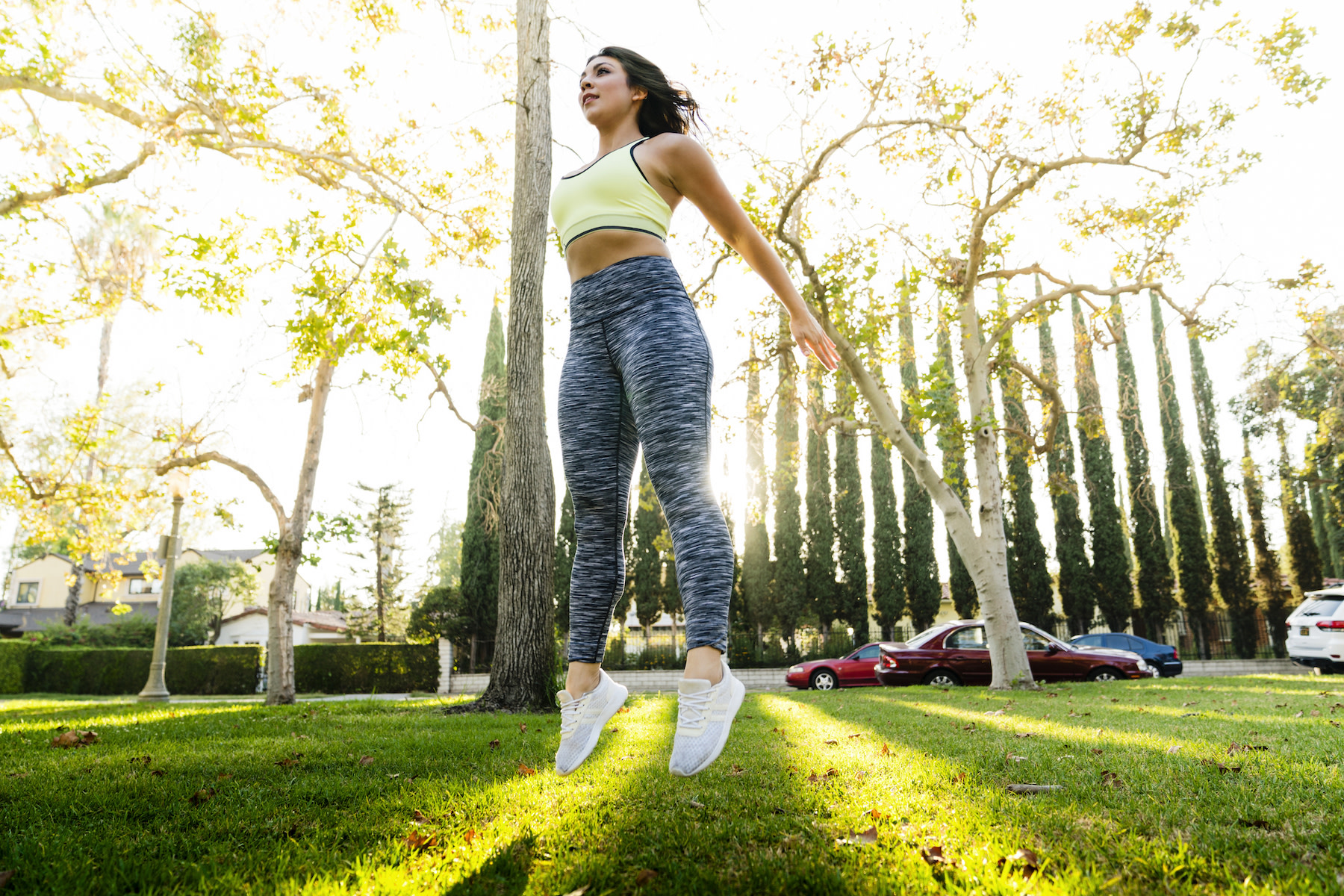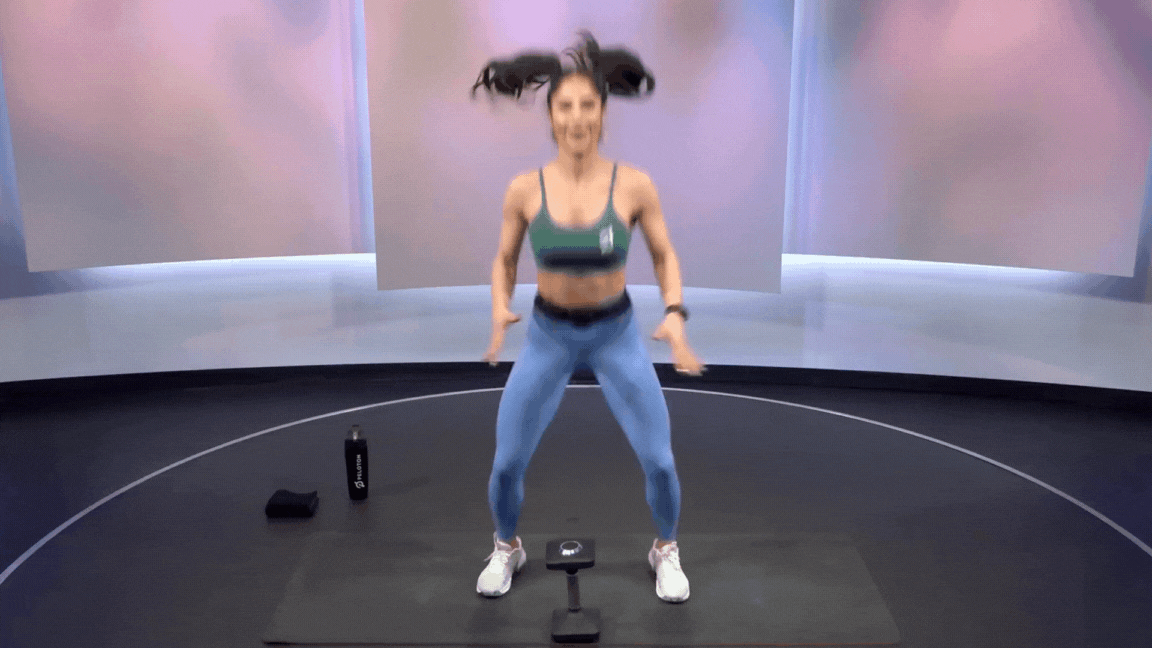
Cavan Images / Cavan via Getty Images
Squats Jumps Can Build Explosive Power and Energize You in Just a Few Reps
Want to increase your lower-body power? Don’t skip this explosive move in your next workout.
By Rachael Schultz•
What Are Squat Jumps?
Muscles Worked When Performing Squat Jumps
How to Properly Do a Squat Jump
Squat Jumps: Modifications and Variations
Common Squat Jump Mistakes
How To Add Squat Jumps to Your Workout Routine (and When to Skip Them)
Squat jumps are one of those seemingly simple movements that can actually have a huge impact on your fitness and conditioning. They’re a fast and efficient way to raise your heart rate and work your lower body, but they also build explosiveness and power while working the oft-overlooked ankle and core stability.
Best yet: Squat jumps are shockingly easy to work into any programming whether you’re focused on weightlifting, HIIT, or building foundational fitness. To learn how, as well as the best modifications and proper form, we spoke with Peloton instructor Cliff Dwenger.
What Are Squat Jumps?
Squat jumps are exactly what they sound like—a squat followed by an explosive jump at the top.
Some might consider these “better” than regular bodyweight squats, but in truth, they simply serve a different purpose. While bodyweight or weighted squats build strength, jump are a type of plyometric exercise, or bursts of intense activity that work to build explosive power in your fast-twitch muscle fibers.
What Are Jump Squats Good for?
All squat variations are some of the best movements to build lower body strength and power. The three main types of squats are bodyweight, weighted, and jump.
Bodyweight and weighted squats are focused on building muscle and strength. Jump squats, on the other hand, are more focused on building power. Cliff explains the benefits of jump squats include:
Increase in explosiveness
Increase in strength endurance (although this is possible to build with bodyweight or weighted squats)
Training the cardiovascular system
Increase in ankle stability
Because of this, jump squats are great for athletes wanting to build strength, endurance, power, and speed.
If you’re new to working out, squat jumps may be a particularly effective way to build power: A 2022 study in Healthcare found when inactive men started doing squat jumps and increased the number of reps over the course of eight weeks, their jumping average, peak power, and velocity all improved. All in all, this added up to a 25 percent improvement in their vertical jump height. (Although Cliff does point out it’s important for beginners to build foundational squat movements before diving into squat jumps.)
Muscles Worked When Performing Squat Jumps
One reason squats are such a beneficial movement is because they enlist some of your largest muscle groups. When you add the jump, squat jumps start to engage a pretty comprehensive range of muscles, including:
Quadriceps: These are the primary drivers behind the descending portion of the squat.
Glutes: Your glutes work in conjunction with the hamstrings to extend your hips and power the jump.
Calves and ankles: These propel the body upward and work to stabilize you during the landing.
Hamstrings: Alongside the glutes, the hamstring muscles help to put power behind your jump.
Core Muscles: You’re engaging your core muscles throughout the exercise to lower into a squat, maintain your posture on the jump, and retain balance when you land.

How to Properly Do a Squat Jump
Start with feet shoulder-width apart, toes pointed forward or slightly turned out. Keep the back straight, chest up and core tight.
Lower down into a squat by bending the knees and hips as if sitting back in a chair. Your weight should be evenly distributed through your feet with a slight emphasis on your heels. Keep the knees behind the toes as you lower.
At the bottom of the squat, begin to initiate the upward movement by pushing through the heels and shifting your weight to your toes.
To jump, in one fluid motion, extend your knees, hips, and arms upward and into a straight position with as much explosive power as you can muster. Your feet should be off the ground and flexed at the top.
Land back on your toes, then immediately shift your weight to your heels. You want to absorb the impact of your landing by fluidly going straight back into a squat position.
Repeat the movement.
Squat Jumps: Modifications and Variations
How To Make Squat Jumps Easier
If you hate squat jumps, rest assured there are modifications that can ease two of the biggest concerns people have with the move, namely that it creates too much stress or impact on your knees or that it skyrockets your heart rate too quickly. For either of these, Cliff advises two variations:
Switch to an “intermediate jump,” where you push out of the bottom of the squat to jump with your feet together and land with them hip-width apart. Then, reset at the top of the squat and start again.
Trade squat jumps for drop squats. Stand with your feet slightly wider than your shoulders, feet parallel or slightly turned out. Jump your feet out as you lower straight down to the bottom of a squat. Often, your arms will naturally fly forward to stabilize you or down to touch the ground. Rise to the start and step your feet back in, to the starting position. That's one.
How To Make Squat Jumps Harder
If you want to make squat jumps harder, Cliff recommends trying:
Weighted squat jumps, wherein you hold a dumbbell in each hand or strap on ankle weights and perform the squat jump.
Jump-and-turns. Here, you’ll perform a squat jump and, on the jump, turn your torso 90°, 180°, or even 360° to land in a different direction. Just be sure to do the same number of reps the other direction to keep it balanced.
Common Squat Jump Mistakes
At face value, squat jumps are super simple—most of us know how to squat and how to jump, after all. But when you combine the two, there are a few common mistakes to watch out for, Cliff says:
Landing with your knees locked: A hard landing—or, abrupt braking, as Cliff calls it—can be too much impact on the knees. Instead, you want to land out of the jump with soft knees and simultaneously lower straight into the squat in one fluid motion. Think more about directly initiating the next squat, rather than about landing, Cliff advises.
Landing with knees caved inward: This changes the muscles that absorb the impact of the jump and can lead to discomfort when you lower into the squat. Instead, keep your knees and toes in one line when you land.
Pushing off the jump from your toes: At the bottom of your squat, shift the weight to your heels before you push off into the jump. This will give you more surface area and leverage to power the jump. You want to land from the jump or the top of the squat on your toes and immediately place the weight on your heels in one fluid motion, Cliff adds.
How To Add Squat Jumps to Your Workout Routine (and When to Skip Them)
Squat jumps build explosiveness, muscular endurance, and cardiovascular fitness and with plenty of variations to make the movement easier or harder, they’re an incredibly versatile exercise to build into any type of workout you’re doing.
Cliff’s top three favorite ways to incorporate squat jumps are:
As a final burnout, particularly as a finisher of a leg session: This helps build muscular endurance after you’ve worked on strength and gives you a little cardio burst.
As part of a HIIT cardio circuit: Perhaps the easiest and most obvious way to work the exercise in, as a plyometric movement, squat jumps are an amazing lower body HIIT move to build strength and endurance with a focus on cardiovascular taxation.
As an element during the “Power Phase” of training: If you’re training for power, squat jumps help build the explosive and strength endurance pieces of that puzzle in conjunction with weightlifting. For example, you might do five reps of barbell back squats, followed by 10 squat jumps. This is for more advanced folks, but it helps push your body to reach new limits, Cliff says.
If you want to try squat jumps out but want to keep it simple, check out Peloton’s HIIT Cardio classes which often utilize the movement.
Cliff says the two people who should skip jump squats are total beginners (who will benefit more from building the foundation of bodyweight squats first), and people who have knee or ankle issues, as the impact of landing can exacerbate these problems (instead, stick to bodyweight or weighted squats).

Peloton App
Access thousands of classes with no equipment needed.
This content is for informational and educational purposes only and does not constitute individualized advice. It is not intended to replace professional medical evaluation, diagnosis, or treatment. Seek the advice of your physician for questions you may have regarding your health or a medical condition. If you are having a medical emergency, call your physician or 911 immediately.
Level up your inbox.
Subscribe for a weekly dose of fitness, plus the latest promos, launches, and events.
By providing your email address, you agree to receive marketing communications from Peloton.
For more about how we use your information, see our Privacy Policy.








